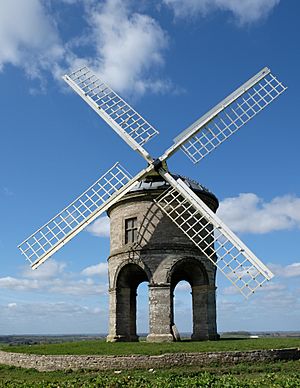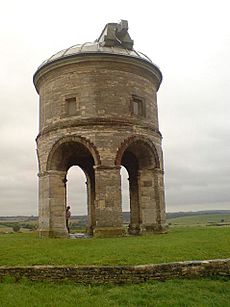Chesterton Windmill facts for kids
Quick facts for kids Chesterton Windmill |
|
|---|---|

Chesterton Windmill in Warwickshire
|
|
| Origin | |
| Mill name | Chesterton Windmill |
| Mill location | Chesterton, Warwickshire, England, UK |
| Grid reference | SP 347 593 |
| Coordinates | 52°13′52″N 1°29′24″W / 52.231°N 1.49°W |
| Year built | 1632 |
| Information | |
| Purpose | Corn mill |
| Type | Tower mill |
| Storeys | Three storeys (including the open lower storey) |
| No. of sails | Four sails |
| Type of sails | Common sails |
| Windshaft | Cast iron |
| Winding | Internal hand winch |
| No. of pairs of millstones | Two pairs |
Chesterton Windmill is a very old stone windmill built in the 1600s. It has a unique round tower and an arched base. You can find it near the village of Chesterton, Warwickshire, in England. It's a famous landmark in the area and is protected as a Grade I listed building, which means it's a very important historic site.
Contents
History of the Windmill
This windmill is one of the most well-known landmarks in Warwickshire. It sits on top of a hill, looking over Chesterton village. It's also close to the old Roman road called Fosse Way.
The windmill was built around 1632 or 1633. It was likely built by Sir Edward Peyto, who owned the Chesterton Manor House at the time. John Stone, a student of the famous architect Inigo Jones, was also in Chesterton working on the new Manor House. He probably helped with the windmill's design too.
Sir Edward was interested in math and stars. Some people thought the tower was first built to watch the stars, like an observatory. However, old records show that it has always been a windmill. This makes it the oldest tower mill in England that still has some of its original working parts.
How It Was Built
The windmill is made from strong local limestone, with details made of sandstone. It stands on a slightly raised area about 71 feet (21.8 meters) wide.
The mill tower itself is about 36 feet (11 meters) tall to the top of its cap. It's special because it stands on six half-circle arches. These arches are supported by piers that spread out from the center. Above the arches, there's a stone band that goes all the way around the tower, just below the windows.
The tower has four windows. Two are small, and two are much larger with stone frames. On the roof, opposite the sails, there's a window with three sections. Above it, you can see a small plaque with the letters "E. P. 1632." This likely stands for Edward Peyto and the year it was built.
How the Windmill Works
The Chesterton Windmill has three levels. The ground floor is open, with the arches. Above that, there are two more floors inside the tower.
The first floor, called the stone floor, is about 15 feet (4.6 meters) above the ground. This is where the heavy millstones are located. These stones grind the grain. You'll also find the main gear wheel and a hoist system here to lift sacks of grain.
The second floor, or hoist floor, has more gears and pulleys for the sack hoist. The main shaft that turns the sails, called the windshaft, is in the cap at the very top. The system that turns the cap to face the wind is also up there.
Until the 1930s, there was a wooden structure inside the arches. It was used to store grain and had a wooden staircase to reach the upper floors. This was removed to protect the mill from damage.
The top of the mill, called the cap, is shaped like a shallow dome. It used to be covered with lead, but now it's covered with aluminum to prevent theft. The cap can rotate easily because it sits on rollers. This allows the miller to turn the sails to face the wind. There's also a wind direction indicator inside the mill, so the miller could adjust it without going outside.
The four large sails are about 60 feet (18.3 meters) wide. They turn counter-clockwise when you look at the mill from the outside. These sails have about 450 square feet (41.8 square meters) of canvas to catch the wind. The mill has a special "in cap" winding gear, which is unusual for English windmills. It's operated by a hand-cranked winch.
Restoring the Windmill
The Chesterton Windmill has been repaired and rebuilt several times over the years. One major repair happened in 1776, and another in 1860.
By 1910, the mill stopped working because its winding gear broke. This meant the last miller, William Haynes, couldn't turn the cap to make the sails face the wind. He left the mill and moved to another one nearby. In the 1930s, the mill was sometimes used when the wind was strong. Minor repairs were done to the sails and wind vane. In the early 1950s, one sail broke off, but it was fixed years later.
A big restoration project started in 1969. The Warwickshire County Council took charge of maintaining the mill and repairing its machinery. The repairs were finished in 1971. Since then, the mill has been open to the public for a few days each summer. Volunteers from nearby villages help run these open days.
In 2006, one of the sails fell off the windmill during an open day. After this, the area around the mill was closed off for safety. The sails were then removed to be made stronger. They were finally put back on the mill in late 2007.
In 1975, the Chesterton Windmill received a Civic Trust Heritage Award for its historical importance and successful restoration.
Similar Tower in the United States
There's a stone tower in Newport, Rhode Island, USA, called Newport Tower. It looks quite similar to Chesterton Windmill.
Most people believe that Newport Tower was built around 1676 by Benedict Arnold, who later became a governor. This was after a wooden mill was destroyed by wind in 1675. The Newport Tower isn't exactly the same as Chesterton Windmill; it has eight round pillars instead of six arches. However, it's very similar in its overall design.
The Arnold family, including Benedict Arnold, moved to Rhode Island in 1635. This, along with old documents showing the Newport Tower was used as a mill, suggests that the Newport Tower was likely inspired by the Chesterton Windmill.
Images for kids





